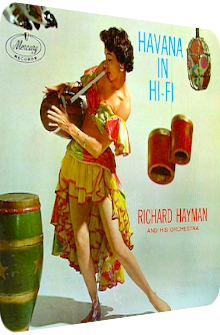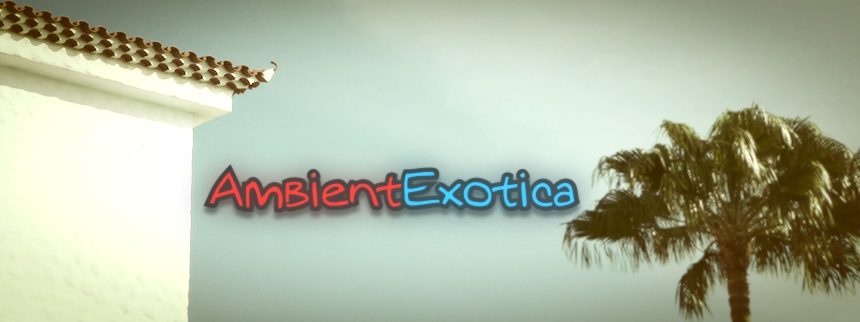
Richard Hayman
Havana In Hi-Fi
1957
Havana In Hi-Fi is a dualistic work of American composer and arranger Richard Hayman (born 1920), released in 1957 on his longtime house label Mercury Records. Spanning nine comparably long tracks, the album shows Hayman trying to complement both the raw street credibility of Cuban composers and Latin musicians with the streamlined symphonic approach that is often rightfully derided as Easy Listening. Here, however, the orchestral aspects are often quite grave, devoted and doleful. This does not come as a surprise, as Latin music has all these tone sequences already enshrined in its chords, even though I am aware of the fact that the term Latin music is as fuzzy or wide a field as equally synthetic terms such as American music, European traditions or ethnic songs, whatever they mean respectively. Anyway, the shaky balance Hayman presents with this album is of note due to the time it is released in.
A successor to Stanley Black’ Festival In Costa Rica (1955) with its genuinely friendly, faithful approach, and a contemporary contestant to Morton Gould’s Jungle Drums (1957), these works represent the symphonic boundaries Havana In Hi-Fi is situated in, with Martin Denny’s milestone Exotica (1956) representing the admittedly gaudy but equally sophisticated dawn of a radically new genre. Richard Hayman is aware of these shifting times by aggrandizing the shakers, bongos and congas in the background. These are still classically Afro-Cuban instruments, true, but their ubiquity is still wonderfully tropical. This makes Havana In Hi-Fi an interesting work for Exotica fans. Sadly, the serious vestiges and overwhelming billows of string infusions might not do, since these are no Space-Age strings. There is much more to write about this album, and I am going to do just that in the following paragraphs.
The cliché level is taken to the max during the opener Rhapsodero, no doubt about that, but there are equally enchanting devices embroidered in here that make this composition a rare feast. Originally envisioned by Bernie Wayne, Hayman’s take not only clocks in at almost seven minutes, he also makes sure that the sunset-colored brass protrusions of devotion and majesty are accompanied by tropical Afro-Cuban conga and bongo undercurrents. The textural wealth is surprising, maybe gimmicky, but of a wide variety. Whether it is the harpsichord-like Flamenco guitars, the pristine fifes whose shrill mellifluousness illumine the sanguine strings or the shifting timbres, Rhapsodero remains multifaceted. The rhapsody later moves to more streamlined, halcyon waters complete with marimba droplets and tambourines before the suite ends the way it began: blotchy, over the top, pompous to the max.
Ernesto Lecuona’s Yo Nada Puedo Hacer is next, otherwise known as My Hopeful Heart. Less orchestral and much more mellow, it comprises of a drowsy afternoon in one’s hammock surrounded by soothing flutes, dreamy vibes and sun-baked strings. The laid-back bongo groove is the decisive evidence that makes this rendition a tropical one, with Lecuona’s subsequent Cordoba reaching for the more doleful tones with stacked strings and horns whose tonality shuttles between affection and contemplation; lonesome desperado guitars fill the gaps between the symphonic segues. Tropical Merengue is only the fourth but final piece of side A and lives up to its title. Written by Don Marsh, Lawrence Elow and Rafael Muñoz, this pizzicato corker surprises with festive strings, a high tempo and a bubbling percussion placenta in the limelight. Merging a Merengue spirit with helicoidal strings, the Cugat-esque performance is almost too genuine to not derive from Cuba or other Latin lands. This one’s for the Exotica fans. There is a reason to feature this album here in this place after all. Phew.
Side B sports five offerings, a whopping three of them originally composed by Ernesto Lecuona, with the first track co-written with Louis Wolfe Gilbert: Maria-La-O is an uncanny patchwork of separated vignettes. Brass fanfares, yearning trombones, good-spirited marimba bubbles and string-heavy sunbursts with adjacent flutes let this piece balance between the diametrically opposite poles. The many quiescent parts at least allow enough room for the drums to shine. Maria-La-O is by no means bad, its shapeshifting gestalt just demands an Exotica listener who is up for the everchanging patterns. Once one adjusts to a certain timbre and surface, it is already replaced by a dead-serious or overly playful sequence. Gabino Peñaloza’s and Juan de Diós Filiberto’s Caminito is much more stable and focused, emanating horns and strings which in tandem sound much more Italian. This impression is annihilated once the typically sweeping shakers reveal this to be a Tango, but of the sunny kind.
The overall benignancy make the aforementioned Caminito a wonderful little piece of delight, especially in view to Lecuona’s La Comparsa whose torero-esque trumpet fusillades scythe through the doldrums before the well-known melody is played by a distant fiddle that would not be out of place in a gypsy-themed album. Curious contrabass backings evoke a slightly sinister shade in an otherwise bright but easygoing ballad. Lecuona’s next piece of sheet music is called I Won’t Stand In Your Way aka Me Has Dejado, a less-considered song in Exotica circles. It is the only piece of this album where Richard Hayman is up for a mercilessly rose-tinted rhizome of romance complete with auroral strings. The occasional bass flute is thrown in for good measure, and a quiet, fragile bongo undercurrent is gurgling below. Even a classic piano is on board, however no archetypically Latin tone sequences are played. The finale is another Lecuona piece co-written with Albert Gamse: Love And The World Loves With You is an Afro-Cuban Waltz of Roman strings, Spanish castanets, Mediterranean flutes and a sustained aquatic fluxion that makes it compatible with water gardens and neon-lit fountains. A disappointing, all too prissy closer.
Havana In Hi-Fi is right in the middle of changing and exciting times, all of them making the Exotica aficionado teary-eyed. Neither a devoted genre shooting star nor a clear-cut artifact that encapsulates one Latin ingredient after the other, Richard Hayman’s album is a curious dob in the greater scheme of things. I write dob and not gem, for it misses a clear focus, a sharpened vision, a pinpointed concept of the intrinsic driving factor. This is not to say that Havana In Hi-Fi gyres few and far between. However, it is also true that Hayman’s understanding of modernism fails to unfold here. These potentially negative aspects aside, there is plenty to reap from the verdured tendrils: the opener Rhapsodero of almost seven minutes length is the amalgamation of classical, dedicated and serious orchestral ornaments on the one hand and spiced counterparts used by street musicians and Jazz musicians such as acoustic guitars and marimba pellets on the other. Not that this has been done before or ever since, but it remains one of the more sophisticated presentations in an Easy Listening context; the take on Maria-La-O is similarly diverse, but steers much more clearly towards exoticism. Richard Hayman has come up with classics such as his only truly exotic opus Voodoo! (1959) and weird appendixes such as Genuine Latin Electric Love Machine (1969), so all in all, Havana In Hi-Fi is definitely valuable from an aesthetic viewpoint, albeit outshone by many other synergetic works reviewed here at AmbientExotica.
Exotica Review 428: Richard Hayman – Havana In Hi-Fi (1957). Originally published on Apr. 25, 2015 at AmbientExotica.com.
